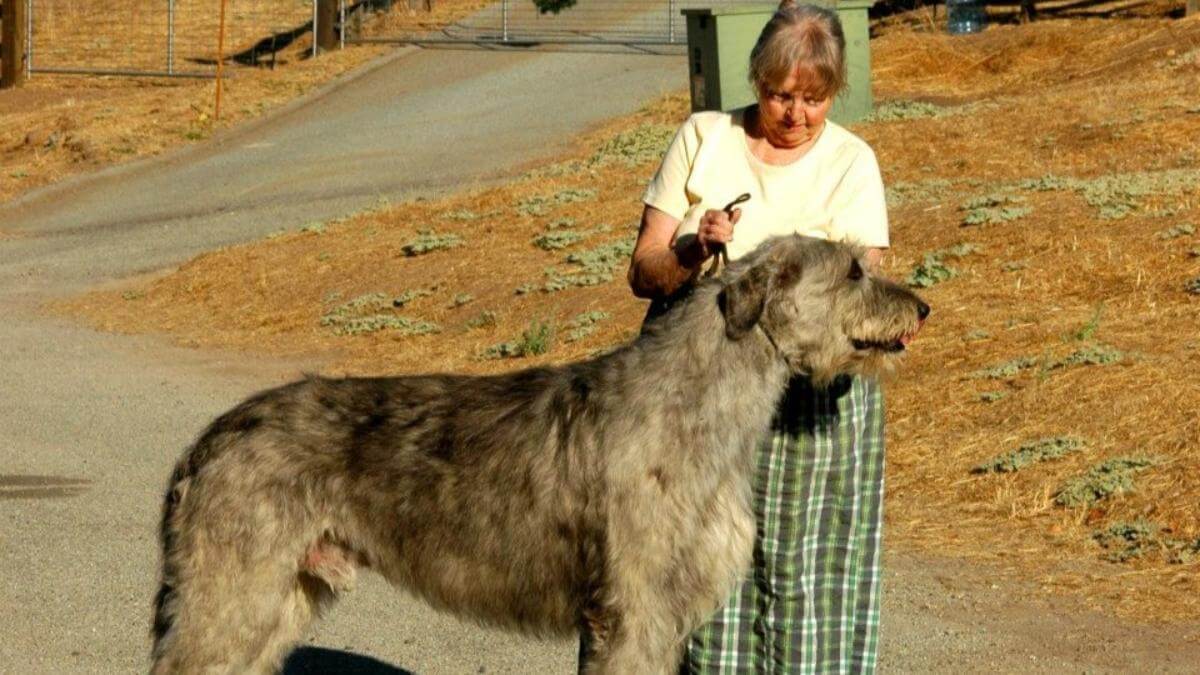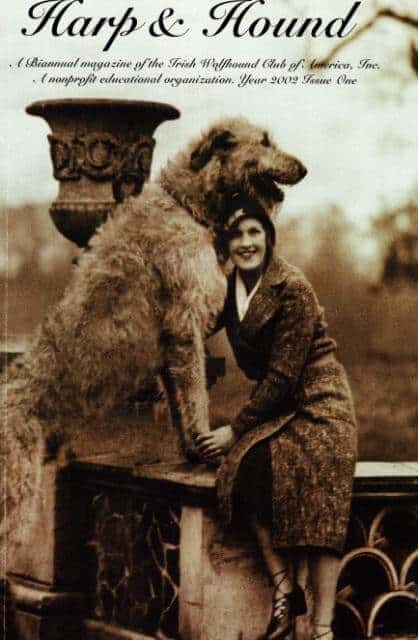
Home » Irish Wolfhound – Annals of the Largest and Tallest of the Galloping Hounds

Throughout history, the Irish Wolfhound has been held in awe and proudly known as the largest and tallest of the galloping hounds. This majestic breed has boasted a rich tapestry of names, initially known as cú faoil in ancient times, Canis Graius Hibernicus in the 9th century, and forever known as the Irish Wolfdog, Irish Greyhound, and Longdog. Renowned for its colossal size and magnificent stature, the Irish Wolfhound’s legacy predates the advent of Christianity.
The origins of the Irish Wolfhound are shrouded in mystery, extolled far and wide in oral traditions suggesting that these magnificent dogs roamed Ireland long before the arrival of the Celts around 500 BC. According to the “Lebor Gabála Érenn” (The Book of Invasions of Ireland), five distinct groups, or cycles, ruled the land before the arrival of the Celts. The first cycle was a race of heroic deities known as the Tuatha Dé Danann, who were said to be accompanied by “great hounds.” This legendary group that governed Ireland resided in the Ancient Boyne Valley, a region famed for its megalithic structures, including Newgrange, a remarkable Stone Age monument. Adding to the fascination surrounding the seemingly ancient origins of the Wolfdog, radiocarbon dating indicates that Newgrange dates back approximately 5,200 years to around 3,200 BC.

Throughout the epochs, descriptions and accounts of the noble Wolfdog have consistently included utterances like “Greyhounds for hunting larger game than a colt,” “Colossal hounds,” “Imperious hounds,” “Great was their bulk,” and “Huge Wolfdogs.”
Even in more recent history, the Wolfdog’s size was documented by 18th-century authors and naturalists as remarkable. The Irish poet, novelist, and playwright Oliver Goldsmith (1728-1774) remarked, “The largest of the ones I have seen—and I’ve observed about a dozen—was roughly four feet high, comparable to a one-year-old calf.”
Thomas Bewick (1753-1828), an English wood engraver, esteemed artist, and natural history writer, noted that the Irish Wolfhound typically stood about three feet tall. Georges-Louis Leclerc, Count de Buffon (1707-1788), a celebrated French naturalist, was recorded as saying that he had never seen more than one and that it was five feet high when sitting.
In the early 1800s, Major H.D. Richardson, who later went to great pains to resuscitate the great hound breed and became an acknowledged authority on both the Irish Wolfdog and the Scottish Deerhound, noted in his 1842 The Dog: Its Origin, Natural History, and Varieties that the analysis of skulls discovered in County Meath and stored at the Royal Irish Academy indicates that the typical height of the Wolfdog was at least 36 to 40 inches.
Sadly, as time marched on, this famous and mighty giant hound, like many other unique species, was on the brink of extinction due to the neglect of the species. The esteemed publication The Sportsman’s Cabinet, Vol. 1, released in 1803, stands as a superb historical document detailing all dog breeds from that era. It reported that “the Irish Greyhound was of a very ancient race, and still to be found in some few remote parts of that kingdom; though they are said to be much reduced, and exceedingly scarce, even in their original climate. They are much larger than the mastiff; exceedingly ferocious when enraged; and, one is said, upon record, to have engaged alternately in combat with the lion and the elephant.”
Fast-forwarding to the latter part of the 19th century, Captain Augustus Graham embarked on a noble mission to revive the Wolfhound breed, dedicating his life to the cause. His 1879 monograph reflects his unwavering belief in the breed’s potential revival, stating, “That we are in possession of the breed in its original integrity is not pretended; at the same time it is confidently believed that there are strains now existing tracing back, more or less clearly, to the original breed… From the general tenor of the accounts we hear of this dog’s dimensions and appearance, it is to be gathered that he was of considerably greater stature than any known race of dogs existing at present and apparently more than equal to the destruction of a wolf.”

His efforts and determination, like those of others before him, stand as a testament to the human spirit’s resolve to preserve heritage. Thus, to revive the ancient breed, he proceeded to obtain any pure strains he could find and, in doing so, determined that the Wolfdog should be at least 33 inches tall to ensure it possessed the necessary speed and strength to capture and dispatch wolves. He noted that measurements of skulls indicated that, in later years, Wolfdogs typically stood between 32 and 34 inches in height, with some individuals reaching up to 35 inches.
It’s reasonable to conclude that the modern-day Irish Wolfhound, resuscitated in the late 1800s, is smaller than the giant described in historical lore and oral traditions. Picture a time, thousands of years ago, when the Cu was genuinely enormous, or even just 250 to 300 years back when it still grew to the size of a one-year-old calf! Following the decline of the wolf and the evolution of human societies, the demand for such massive dogs lessened, leading to a rebirth of the breed that adapted to these new circumstances.
Remarkably, the original 1885 Wolfhound Breed Standard remains our guiding blueprint today, except for the height reference, which is slightly higher in the current AKC (American Kennel Club) Breed Standard. This is quite rare and significant, as only a handful of breeds can claim to have retained their original Standards—those penned by their forebears in 1885—in such a manner.
To truly appreciate this legendary hunter, aspiring fanciers and judges must understand its distinct characteristics. Envision a hound that boasts a graceful build coupled with impressive musculature. To clarify our general description, two phrases that are often repeated but frequently misinterpreted are “commanding appearance” and “great size.” A commanding presence doesn’t just hinge on size. In the world of Irish Draught horses, there’s a phrase, “standing over a lot of ground,” that perfectly encapsulates what it means to have a commanding demeanor. This idea is equally applicable when observing a Wolfdog; note how much ground he stands over and whether he seems to own that space. When the hound looks at you, he exudes confidence and dignity, two key elements that contribute to a commanding presence. However, the ability to “stand over a lot of ground” effectively depends on having the correct shape and proportions. It is not simply about being square or rectangular; the ideal shape corresponds to the curves and fluidity being Greyhound-like.
The Standard describes the requirement as of “great size.” However, simply having a large hound doesn’t quite capture the true intent of those who established this Standard. There’s a common misconception surrounding this aspect. It’s essential to recognize that great size encompasses more than just height. That’s right—“great size” isn’t measured solely by how tall the hound is.

I will clarify this apparent contradiction. While the idea of “great size” often evokes thoughts of height, it encompasses a broader range of traits. The original 1885 Standard for the Wolfdog specified a minimum height of 31 inches, but today’s AKC Standard raises that bar to 32 inches. Nowadays, we occasionally come across Wolfhounds that reach nearly 35 inches at the shoulder. However, many of these taller hounds tend to have light frames, lacking substantial bone structure and featuring narrow rib cages, which is often referred to as slab-sidedness. Therefore, they do not fit the definition of a Wolfhound of “great size.” Great size refers to a hound’s overall mass and presence, encompassing factors such as the diameter, density, and length of its bones and the weight and length of its muscles. These factors
are significant because all four recognized Wolfhound Standards—the AKC, The Kennel Club (England), the Irish Wolfhound Standard of Ireland, and the 1885 Graham Standard—emphasize the need for a muscular build. Effectively, size is defined as a physical magnitude, extent, or bulk showcasing considerable proportions.
To capture the essence of a rough-coated breed that resembles a Greyhound, the Wolfhound should exhibit a graceful physique. This aspect is often misinterpreted, with some enthusiasts mistakenly believing it implies a slighter frame, less spring of rib, and a longer loin. It’s important to remember that while a Greyhound is designed for sprinting and often stoops to do its work, a Wolfdog is built for endurance hunting, though still maintaining a swift, athletic form. The late Lois Thomasson, the esteemed authority on Wolfhounds of our modern day, eloquently explained, “The Greyhound is an extraordinary, almost mystical breed, the epitome of speed in chasing game. When we refer to the Irish Wolfhound as Greyhound-like, we mean it has long limbs, a robust body, a tucked belly, arched loins, and well-defined muscles in its rear.”
The significance of the word “long” is crucial when it comes to galloping hounds. Features such as long limbs, extended bone lengths, a spacious rib cage, and an elongated body all play vital roles. In fact, the term appears no fewer than thirteen times within the Wolfhound Standard. According to the General Appearance section, a striking emphasis on length underscores this breed’s physical attributes and is paraphrased as follows: “Proportionate length of body is the ideal to strive for, and it aims to establish a breed that averages between 32 to 34 inches at the shoulder in dogs…”
With a sense of nostalgia, I find it fitting to wrap up our discussion on the largest and tallest of the galloping hounds with a nod to Major Richardson, who expressed it beautifully when he wrote, “This renowned and redoubted animal (from age to age in tradition, and in song, one of the glories of ‘The Sacred Isle’ and with his kindred, unrivaled race, the Irish giant deer, her recognized emblem from among her animated tribes – celebrated and extolled by all authors and lovers of natural history, native and foreign, and of universal fame in his own country) – has been long ranked in peerless dignity, facile princeps, at the head of the whole dog family.”
